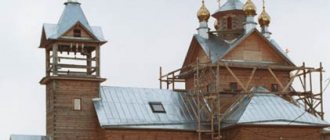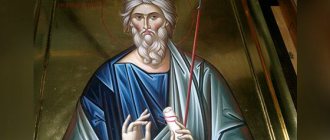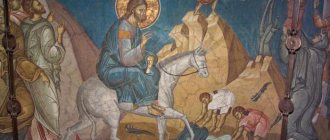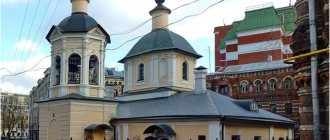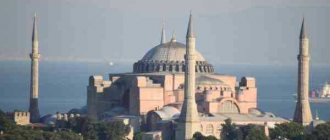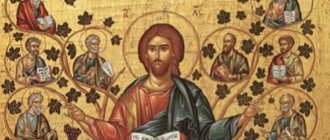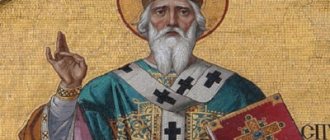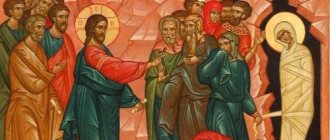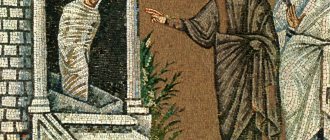"Save me, God!".
Thank you for visiting our website, before you start studying the information, please subscribe to our Orthodox community on Instagram, Lord, Save and Preserve † - https://www.instagram.com/spasi.gospodi/. The community has more than 60,000 subscribers. There are many of us like-minded people and we are growing quickly, we post prayers, sayings of saints, prayer requests, and timely post useful information about holidays and Orthodox events... Subscribe. Guardian Angel to you!
Orthodoxy is rich in the faces of Saints. Sometimes it can be difficult to figure out who to pray to and what to ask for. Each icon has its own purpose. For example, many have heard about the icon of St. Andrew the First-Called. What does it mean and what is it responsible for? Let's talk about everything in detail.
Life of St. Andrew the First-Called
In ordinary life, the Apostle Andrew the First-Called was called Andrei Zavedeev. He was a simple fisherman. He was often interested in various spiritual issues. When he met John the Baptist, he became his disciple. Many considered him the Messiah Himself. He denied this and said that he was the one who was preparing this path for Him. Andrew the First-Called and his brother followed the prophet.
One day, during a baptism in the Jordan, they saw their mentor pointing his finger at a man. He said that it was he who would take upon himself the sins of people. It was after this that Peter also joined the disciples of the Lord. For some time they still lived with their families and fished for food, although later they devoted themselves to serving God. There is not much information about Andrei himself; more information is about his actions.
Andrew the First-Called was next to the Lord throughout His entire life: at the Last Supper, after His Resurrection, at the Ascension of the Lord, and also the Holy Spirit descended on him at Pentecost. After this, all the apostles chose by lot the countries where they were to go to preach the Christian faith. He inherited the Black Sea coast and territory further north.
The best article for you, go to: Icon of the Archangel Gabriel meaning and what it helps with
Many historians believe that he was in Crimea, parts of Ukraine, Kuban and the Caucasus. Although there is no exact confirmation of this information.
Just like the rest of the apostles, his teaching met resistance from the pagans. Sometimes it even brought him not only spiritual, but also physical suffering.
In order to convince people of the correctness of following the Christian faith, Andrew the First-Called performed many miracles thanks to his prayers. Seeing such miracles, many people joined Orthodoxy.
During the persecution of Christians, Andrei returned to Rome. There he decided to defend and defend the Christian faith before the Roman governor Aegeat. In this dispute, Egeat said that the apostle would die the same death as his Teacher. He was captured and put in prison, where he awaited execution. People understood that he was innocent and even wanted to start a riot. But Andrei dissuaded them, saying that such suffering would bring him eternal glory.
He hung on the slanting cross for two days as an apostle and continued calling for humility and reading sermons. It was a painful death and after it he went to God.
Feast of St. Andrew the First-Called
Each saint has his own day of remembrance. So, the day of remembrance of the Apostle Andrew the First-Called is considered to be December 13 and July 13. It is on this day that many go to temples and read prayers.
Sermon and miracles
Saint Andrew had the opportunity to preach in many lands inhabited by pagans. From Church Tradition and the Apostolic Acts it is known that he visited many countries, crossed the Bosphorus Strait, and rose to the territory of modern Novgorod.
Cities and countries in which the apostle preached:
- Bithynia is a province of the Roman state, located between the Bosporus Strait and the Sangarius River;
- Propontis - region of the Sea of Marmara;
- Thrace and Macedonia are territories in the Balkans;
- Scythia is a vast region on the Eurasian continent north of the Black Sea;
- Thessaly, Hellas and Achaia are historical regions in the territory of modern Greece;
- Amastrida, Trabzon, Sinop and other Turkish cities;
- Bosporan Kingdom;
- lands of the Alans, Zigs and Abasques tribes;
- Varangian and Slavic tribes.
Andrew the First-Called preached the Holy Gospel, founding churches and ordaining elders, also performing many miracles to confirm the faith.
The legend about the life of the apostle has brought down to this day a description of the cases of resurrection from the dead performed by him. Thus, in the city of Nicomedia, Saint Andrew, during a funeral, resurrected a dead man - a boy torn to pieces by dogs. In the city of Amaseev, the apostle resurrected a youth named Egyptius, who had died of a fever. In Thessalonica, Andrew the First-Called, in front of people, resurrected a boy who had died from strangulation and a boy who had been bitten by a snake.
In the city of Patras, during the saint’s sermon, the waves carried out the body of a drowned man, the Macedonian Philopatra, whom the apostle resurrected. As it turned out, Philopatra was heading to Patras in order to get acquainted with the new teaching. The resurrected man asked the apostle to resurrect his friends and servants who had been washed off the ship into the sea along with him. Through the prayer of Saint Andrew, 39 more bodies washed ashore, which the apostle ordered to be collected in one place and, after praying, resurrected them.
What do they pray to St. Andrew the First-Called?
Most often this Saint is approached with requests for:
- Conversion to Christianity
- Help for seafarers
- Defense of the Fatherland
- Help for foreign language teachers and translators
- Strengthening Faith
- Unity of the people under Christian leadership
- Happy marriage.
The best article for you, go to: The Icon of the Mother of God Gerontissa, what it helps with, what they pray for
How does Andrew the First-Called help? Most often, sailors and their families turn to him. Before going to sea, they even hold a service specifically for St. Andrew the First-Called. This is done so that he helps them on the hike, as well as for a safe return home. The flag of the navy also depicts the St. Andrew's Cross.
Patron of Russia
50 days after the Resurrection of Christ, the Holy Spirit descended on the apostles, after which they all went to different lands to bring the Good News. Apostle Andrew went to the eastern countries: through Asia Minor, Crimea and the Black Sea region he reached the places where Kyiv was later founded. He blessed these places by erecting a cross on one of the Kyiv mountains.
Tradition says that, finding himself in the area of modern Kyiv, the apostle said to his disciples: “Do you see these mountains? The grace of God will shine on these mountains, there will be a great city, and God will build many churches.”
Icons of the Holy Apostle Andrew the First-Called
The Apostle Andrew also visited the Slavic settlements on the site of Novgorod. Returning back to the Roman lands, he founded a small Byzantine village, which over time became the second Rome - Constantinople.
On a note! It was from Byzantium that Rus' received Baptism, and from the Byzantine emperors Palaiologos John III adopted the idea of an Orthodox state.
Icon of St. Andrew the First-Called
There are many icons and copies of the Apostle Andrew the First-Called in the world. Here are some temples where you can see such holy faces:
- Church of the Apostle Andrew the First-Called in Moscow at the Vagankovskoye cemetery. There is a revered icon of this Saint.
- Church of the Mother of God “Joy of All Who Sorrow” on Ordynka, where the icon with a piece of relics is located
- Temple of Sioni (Assumption of the Mother of God) in Georgia, where the myrrh-streaming icon is located
- Patriarchal Cathedral of the Holy Trinity in Tbilisi. The icon that is there is unusual. It is carved from wood.
There are also other venerated relics and icons of this Saint. They are:
- Pyzhki Moscow - St. Nicholas Church
- Kuzminki Moscow - Temple of the Blachernae Icon of the Mother of God
- Golyanov – Church of St. Zosima and Savvaty of Solovetsky
- Diveevo - Church of St. Andrew the First-Called.
You can pray to this Saint at the image of his face. And here is the prayer itself to the Apostle Andrew the First-Called:
First-Called Apostle of God and our Savior Jesus Christ, Church follower, all-praised Andrew! We glorify and magnify your apostolic works, we sweetly remember your blessed coming to us, we bless your honorable suffering, which you endured for Christ, we kiss your sacred relics, we honor your holy memory and believe that the Lord lives, and your soul lives and is with Him. forever remain in heaven, where you love us with the same love with which you loved us, when by the Holy Spirit you saw our conversion to Christ, and not only loved, but also prayed to God for us, in vain in His light all our needs.
Thus we believe and thus we confess this faith in the temple, which in thy name, Saint Andrew, was most gloriously created, where thy holy relics rest: believing, we ask and pray to the Lord and God and our Savior Jesus Christ, that through thy prayers he may ever hear and he accepts and will give us everything we need for the salvation of us sinners: yes, as you are, according to the voice of the Lord, leave your hesitation, you have steadfastly followed Him, and let everyone from us seek not his own, but for the creation of his neighbor and for the heavenly calling, yes thinks.
Having you as an intercessor and prayer book for us, we hope that your prayer can accomplish much before our Lord and Savior Jesus Christ, to Him belongs all glory, honor and worship with the Father and the Holy Spirit and forever and ever. Amen.
It doesn’t matter what words you use to ask for help. The main thing is that they come from a pure heart.
The Lord is always with you!
The best article for you, go to: Icon of St. Gerasimos of Jordan
Watch the video about the Holy Apostle Andrew the First-Called:
How to get to the Church of the Apostle Andrew the First-Called
The temple is under the control of the Patras Metropolitanate of the Greek Orthodox Church and is the largest temple in Greece. Free admission.
Relics of the Apostle Andrew in the Cathedral of St. Andrew the First-Called (Patras, Greece)
You can get there by train (St. Andrew station, located 400 meters from the cathedral) or taxi. But the best option would be to visit the temple along an excursion route from another city.
On a note! The cathedral is open to the public from 8.00 to 11.00 and from 16.30 to 19.00 daily.
Exterior of the cathedral
Before climbing the stairs, let's admire this beautiful example of Amalfi architecture, this Byzantine-Tuscan-Moorish fusion.
The façade of the cathedral was erected in 1891 to replace the previous one that had collapsed.
The bell tower of the cathedral was built in 1180-1276
The tympanum is decorated with mosaics
Triumph of Jesus Pantocrator
Apostles
The entrance to the church is hidden in the depths of the gallery. The bronze gates for the church were brought from Constantinople. The year of their creation is 1060.
On the gallery of the cathedral
The gallery overlooks the Church of San Biagio (St. Vlas) on the other side of the valley
Christian service
The apostles cast lots, choosing the direction of their further journey. Saint Andrew had the opportunity to travel to the lands lying on the Black Sea coast. Almost everywhere the preacher brought the good news, he was greeted unfriendly. The authorities expelled the saint from the cities, the population insulted him and did not allow him to spend the night. In Sinope, the pagans subjected the persistent Christian to cruel torture, but Andrew’s crippled body was healed by the will of God.
Icon of St. Andrew the First-Called
Finally, in the Thracian city of Byzantium, the stories and miracles of the saint made an impression on the people. In the future center of Eastern Christianity, the apostle found 70 disciples and founded the Church, which was headed by Bishop Stachy, ordained by Andrew the First-Called. Andrew appointed elders of the church, instructed them to perform the sacraments and instruct the people, and he himself went on.
The preacher not only healed his own body, but also raised the dead. The life of the saint mentions four unnamed boys and two men who died from different causes. The miracle of the resurrection invariably led to the baptism of witnesses to the event. In Thessalonica they tried to kill the apostle with wild animals, but the leopard, instead of the saint, strangled the son of the proconsul Virinus. Andrew's long prayer brought the child back to life.
Church of the Apostle Andrew the First-Called on Vuoksi
In Patras, the apostle raised forty drowned people who were heading to him from Macedonia. The ship with Andrei's future students capsized during a storm, but the sea carried all the bodies ashore and thanks to the power of the saint's prayer, everything ended well. This legend explains the veneration of St. Andrew as the patron saint of sailors. In the Georgian city of Atskuri, just one resurrection was enough to convert the townspeople to Christianity.
Christian historians supplemented the gospel narrative with their own versions of the preacher’s further journey. Eusebius of Caesarea wrote about Andrew's ministry in Scythia. In 1116, the monk Sylvester, by order of Vladimir Monomakh, included in the Tale of Bygone Years the legend about the mission of St. Andrew the First-Called in Rus'.
Painting “Apostle Andrew the First-Called erecting a cross on the Kyiv mountains”, Nikolai Lomtev
Later, the life was supplemented by a detailed account of the saint’s journey from Crimea to Rome via Ladoga. According to this version, Andrei climbed up the Dnieper and, after spending the night on the picturesque hills, saw in a dream a large city with churches. The next morning he told his companions about this dream, predicting the foundation of Kyiv in that place, blessed the hills and erected a cross on one of them.
Then the apostle, tired from the journey, took a steam bath in the baths of Novgorod, which he later told his friends about in Rome. In the Middle Ages, the legend acquired details: about the erection of a wooden cross near the village of Gruzino on the banks of the Volkhov and a stone one on the island of Valaam, about the destruction of the temples of Veles and Perun and the conversion of former priests to Christianity. Be that as it may, residents of Ukraine and Russia venerate St. Andrew the First-Called as their patron.
Memory
- 1698 – Peter I established the Order of St. Andrew the First-Called
- 1754 – St. Andrew’s Church was built in Kyiv
- 1865-1940 – Church of St. Andrew the First-Called and St. Mary Magdalene in the village of Palkeala
- 1899 – the steamship “Andrei Pervozvanny” was launched, the first specially built research vessel of the Russian Empire
- 1906 – St Andrews Football Stadium opens in Birmingham
- 1906 – the battleship “Andrei Pervozvanny” was launched
- 1974 – The Cathedral of St. Andrew the First-Called was built in the city of Patras on the Peloponnese Peninsula
- 1991 – the song “Walking on Water” by Nautilus Pompilius was recorded
- 1992 – The Foundation of the Holy All-Praised Apostle Andrew the First-Called was founded
- 2003 – a monument was opened in Bataysk
- 2006 – a monument was unveiled in Moscow
- 2007 – St. Andrew’s Church in Kaliningrad was consecrated
- 2008 – raid of the charitable medical and educational Orthodox ship-church “Andrew the First-Called” through remote villages of the Novosibirsk region
Death
The apostle suffered martyrdom in the Greek city of Patras in approximately 67 of the first century. Saint Andrew lived in this city for several years, preaching and leading the Christian community. The city governor Egeat considered that the activities of Christians undermined his power, and ordered the execution of the obsessive preacher on the cross. Taking into account the wishes of the saint, who considered himself unworthy to imitate the death of Jesus, the weapon chosen was an oblique cross, later called St. Andrew’s.
Martyrdom of Saint Andrew the First-Called
Andrew the First-Called was not nailed to the cross, but his hands and feet were tied to the crossbars. For two days the apostle preached to his disciples from the cross. The listeners demanded to stop the torture, threatening a riot, and Egeates ordered the guards to untie the martyr. However, the saint was already determined to die and the knots did not succumb to the efforts of the soldiers. When the soul of the holy apostle left his body, the cross shone brightly, and then a source began to gush at this place.
The relics of Saint Andrew and the cross on which he died were first kept in Patras, but in 357, by order of the Roman Emperor Constantius II, they were transported to Constantinople and placed in the Church of the Holy Apostles. In the 9th century, the head and remains of the cross were separated from the relics and returned to Patras. After the capture of Patras by the Ottomans in 1460, Thomas Palaiologos saved the head of the saint and parts of the cross from desecration and handed over the shrine to Pope Pius II.
St. Andrew's flag
In 1964, the shrine returned to Patras thanks to an agreement between Pope Paul VI and representatives of the Greek Orthodox Church. The head of the saint is kept in the Cathedral of St. Andrew the First-Called, built in 1974 near the source. In the largest Orthodox church in Greece, there is also an oblique cross-reliquary, in which are embedded parts of the very cross that served as the instrument of death of the saint.
In the old Church of the Apostle Andrew, located next to the cathedral, part of the finger of the Apostle is kept. The shrine was presented to Patram in 1847 by Russian nobleman Andrei Muravyov, who received it from the monks on Mount Athos. The remaining relics are scattered and kept with honor in different European cities.
Relics of St. Andrew the First-Called
According to legend, the Greek monk Regulus, at the direction of an angel, took the relics of St. Andrew to Scotland. The village where the monk's ship landed turned into the city of St. Andrews, which became the ecclesiastical capital of the kingdom. The relics are kept in the city's cathedral, and the Apostle Andrew is revered as the patron saint of Scotland.
Another legend says that in 1208 the crusaders took the relics to the Italian city of Amalfi, where they are kept in the local Cathedral of St. Andrew, built in the rarest Norman-Byzantine style. In Germany, a sandal and a nail from the saint's cross are kept in the Trier Cathedral. Some of the relics of St. Andrew ended up in the cathedral of the Italian city of Mantua.
Painting “St. Andrew the Apostle”, Artus Wolfforth
In Russia, there is the Foundation of the Holy All-Praised Apostle Andrew the First-Called, a public organization that delivers the main Christian relics to parishioners of the Russian Orthodox Church. The Foundation annually delivers from Jerusalem the Holy Fire, which descends from heaven during the Easter service. In 2011, the organization brought the Belt of the Blessed Virgin Mary to Russia.
Traveling Preacher and "Fisher of Men"
Apostle Andrew witnessed the main events of the earthly life of Jesus Christ, including his death and resurrection. The Gospel of Mark says that Andrew the First-Called was one of the four apostles to whom the Savior on the Mount of Olives revealed the destinies of the world. And after the ascension of Christ, the Apostle Andrew went to preach Christian teaching to all nations. According to legend, Christ's disciples cast lots, determining where each of them should go with sermons, and Andrew got the lands to the north: towards the Black Sea, Danube and Dnieper.
“With his very first word addressed to brother Simon, the Apostle Andrew had already begun to fulfill the calling about which Christ spoke to his disciples: that from fishermen they would become “fishers of men,” that is, they would gather the people of God - the Church. And this, too, shows the essence of his first calling: it is not enough to be the first to respond, it is not enough to become a disciple of Christ yourself: you need to make this call from God clear, accessible to others,” says Svetlana Yashina.
It is no coincidence that Christ gives the apostles the commandment: “Go and make disciples of all nations, baptizing in the name of the Father, and the Son, and the Holy Spirit.”
“The entire remaining earthly life of the Apostle Andrew the First-Called was dedicated to the fulfillment of this commandment. He brought the light of faith to Byzantium, which was later to become the center of the Orthodox world. He traveled through Asia Minor, Thrace, Macedonia, the Black Sea coast, the Crimea and the Black Sea region, which became the first field of his apostolic ministry, and everywhere he preached the new faith and performed miracles in the name of the Lord. For example, church traditions claim that through the prayers of St. Andrew the First-Called the dead were resurrected at least nine times; and the most famous legend about the life of this apostle remains the story of how, through his prayers, the Lord brought back to life 40 sailors and fishermen who drowned on the way to the city of Patras, where they intended to listen to Andrei’s sermon,” says Yashina.

